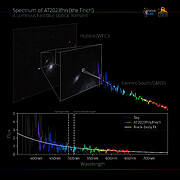Gemini South Captures Cosmic ‘Finch’
The latest addition to the cosmic collection of Luminous Fast Blue Optical Transients raises new questions about the origins of these powerful yet enigmatic explosions
5 October 2023
Using data from Gemini South and other observatories, astronomers have found a new Luminous Fast Blue Optical Transient (LFBOT), a powerful but poorly understood type of cosmic explosion. However, rather than being nestled in a star-forming galaxy like other LFBOTs discovered so far, the latest event, dubbed ‘the Finch’, occurred in the far outskirts of a galaxy. This observation calls into question leading ideas about the origins of these transient events.
In 2018 astronomers witnessed an intense explosion far more powerful than the average supernova — 10 –100 times brighter. It was designated AT2018cow, nicknamed ‘the Cow’, and became the first example of a new class of astronomical phenomena: luminous fast blue optical transients (LFBOTs). Only a handful of these curious events have been confirmed to date, each given a clever zoological name inspired by the last few letters of its astronomical designation, including the Camel, Koala and Tasmanian Devil. The physics of how these objects form remains a mystery, and now the latest addition to the LFBOT collection raises more questions than it answers.
LFBOTs shine intensely blue and they evolve rapidly, reaching peak brightness and fading again in a matter of days, unlike supernovae which take weeks or months. Drawing on data from several telescopes, including Gemini South, one half of the International Gemini Observatory operated by NSF’s NOIRLab, an international team of astronomers identified a transient, designated AT2023fhn and nicknamed ‘the Finch’, that shows all the tell-tale characteristics of an LFBOT with an additional, unexpected characteristic.
Unlike any other LFBOTs seen before, the Finch is an unusually long way from either of its two nearest galaxies — about 50,000 light-years from a nearby spiral galaxy and about 15,000 light-years from a smaller satellite galaxy. Not only does this discovery not align with past LFBOT locations within star-forming galaxies, but it raises problems for some of the existing explanations of the origin of LFBOTs. While these rare explosions have been assumed to be a rare type of supernova, the gargantuan stars that turn into supernovae live short lives by stellar standards, meaning that no such star would have time to travel such a great distance from its home galaxy before exploding.
“The more we learn about LFBOTs, the more they surprise us,” says astronomer Ashley Chrimes, lead author of the paper reporting the discovery. “We’ve now shown that LFBOTs can occur a long way from their nearest galaxy, and the location of the Finch is not what we expect for a supernova.”
Astronomers have been on the hunt for more of these enigmatic events since the Cow was discovered in 2018. Since astronomical transients can pop up anywhere and at any time, and are relatively fleeting in astronomical terms, researchers rely on wide-field surveys that can continuously monitor large areas of the sky to detect them.
It was one such survey — the NSF-funded Zwicky Transient Facility — that first alerted astronomers to the Finch earlier this year. Once it was spotted, the researchers triggered a pre-planned program of observations that had been on standby, ready to quickly turn their attention to any potential LFBOT candidates that arose. This included observations with the Gemini Multi-Object Spectrograph (GMOS) instrument on the Gemini South telescope.
GMOS measured the temperature of the Finch to be a scorching 20,000 degrees Celsius (approximately 36,000 Fahrenheit) and helped determine its distance from Earth so its luminosity could be calculated. Together with other observations, these findings confirmed the explosion was indeed an LFBOT. However, the mystery of the Finch’s origin, as well as how it ended up so far away from its host galaxy, remains.
Besides the speculation that LFBOTs are a particularly rare class of supernova, scientists have several other ideas about how they could form. For example, they could be the result of stars being torn apart by black holes, but Chrimes notes that finding a black hole so far from a galaxy is also not expected. To explain the unusual location of the Finch, the researchers are considering the possibility that it was the explosion of an extremely fast-moving star. Alternatively, it could be the culmination of a much longer process, such as a collision of two neutron stars that have been spiraling toward each other for billions of years, though these are mere speculations.
The Finch may have caused problems for current theories of the nature of LFBOTs, but in science it is often the surprising results that reveal the gaps in our knowledge and lead to advances in our understanding of the Universe. “The discovery poses many more questions than it answers,” says Chrimes. “More work is needed to figure out which of the many possible explanations is the right one.”
Answers to the curious nature of LFBOTs are on the horizon with the upcoming Legacy Survey of Space and Time (LSST), conducted with Vera C. Rubin Observatory in Chile. As a survey telescope, the Rubin Observatory will observe and take images of the entire southern night sky every few nights, which means it will detect millions of objects that change brightness over time, including LFBOTs. As the sample size of these mysterious objects grows, so will astronomers’ understanding of them. What cosmic zoological creature will be discovered next?
More information
Reference: A. A. Chrimes, P. G. Jonker, et al. 2023, AT2023fhn (the Finch): a Luminous Fast Blue Optical Transient at a large offset from its host galaxy, DOI 10.48550/arXiv.2307.01771
NSF’s NOIRLab, the US center for ground-based optical-infrared astronomy, operates the International Gemini Observatory (a facility of NSF, NRC–Canada, ANID–Chile, MCTIC–Brazil, MINCyT–Argentina, and KASI–Republic of Korea), Kitt Peak National Observatory (KPNO), Cerro Tololo Inter-American Observatory (CTIO), the Community Science and Data Center (CSDC), and Vera C. Rubin Observatory (operated in cooperation with the Department of Energy’s SLAC National Accelerator Laboratory). It is managed by the Association of Universities for Research in Astronomy (AURA) under a cooperative agreement with NSF and is headquartered in Tucson, Arizona. The astronomical community is honored to have the opportunity to conduct astronomical research on Iolkam Du’ag (Kitt Peak) in Arizona, on Maunakea in Hawai‘i, and on Cerro Tololo and Cerro Pachón in Chile. We recognize and acknowledge the very significant cultural role and reverence that these sites have to the Tohono O’odham Nation, to the Native Hawaiian community, and to the local communities in Chile, respectively.
Contacts
Ashley Chrimes
European Space Agency
Email: Ashley.Chrimes@esa.int
Josie Fenske
NSF’s NOIRLab Communications
Email: josie.fenske@noirlab.edu





